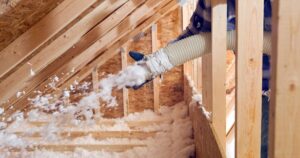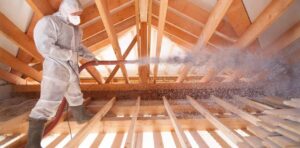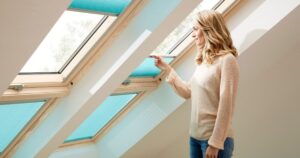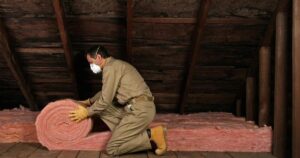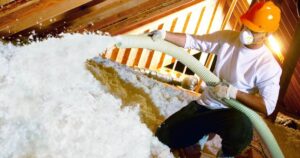Attic insulation cost refers to the total expense incurred in installing insulation material in the attic space of a building. This cost includes materials, labor, and any additional expenses associated with the insulation process. The overall expenditure varies based on factors such as insulation type, square footage, and professional installation services.
Curious about the financial aspects of attic insulation? Understanding the real cost involves considering insulation materials like fiberglass or cellulose, evaluating the size of your attic, and factoring in labor expenses. Uncover the nuances of attic insulation costs to make informed decisions about enhancing your home’s energy efficiency.
Attic insulation costs range depending on factors like material quality and the size of the space. On average, homeowners can expect to invest a certain amount per square foot. Exploring different insulation options and obtaining quotes from professionals will help you determine the most cost-effective solution for your specific needs.
Attic Insulation Cost by Type Per Square Foot
The cost of attic insulation varies by type and is often calculated per square foot. Fiberglass insulation, a common choice, may range from $0.40 to $1.20 per square foot. Alternatively, cellulose insulation costs approximately $0.45 to $1.25 per square foot. Spray foam insulation, known for its effectiveness, tends to be pricier at $1.50 to $3.50 per square foot. Overall, understanding the cost per square foot for different insulation types helps homeowners make informed decisions based on their budget and insulation needs.
Insulation Replacement Cost

Insulation replacement cost refers to the expenses associated with upgrading or replacing insulation materials in a building. The cost varies based on factors such as the type of insulation, square footage, and labor charges. High-quality insulation replacement can enhance energy efficiency, resulting in potential long-term savings on heating and cooling bills. Professional assessment is crucial to determine the specific insulation needs and replacement costs for optimal results. Investing in insulation replacement is a proactive step toward maintaining a comfortable and energy-efficient living environment.
Benefits of Insulating Your Attic
Insulating your attic offers various benefits for your home. Firstly, it helps regulate indoor temperatures, keeping your living spaces comfortable in both hot and cold weather. Additionally, attic insulation aids in energy efficiency, reducing heating and cooling costs. It acts as a barrier, preventing heat transfer between your home and the outside environment. Insulation also contributes to a quieter home by minimizing external noise. Lastly, a well-insulated attic can prevent moisture buildup, reducing the risk of mold and other related issues, ultimately creating a healthier living environment Insulation Really Cost.
DIY Attic Insulation Cost vs. Hiring a Professional
When considering DIY attic insulation versus hiring a professional, costs and outcomes vary. Doing it yourself may seem cost-effective initially, but purchasing quality materials and tools can add up. Additionally, improper installation might lead to energy inefficiency. Hiring a professional ensures proper insulation and may save money in the long run. Comparing the expenses and benefits will help determine the most practical and efficient choice for your attic insulation needs.
Tips to Save Money on Attic Insulation
Saving money on attic insulation is achievable with a few simple tips. First, consider DIY insulation installation to cut down on labor costs. Research and compare insulation materials to find cost-effective yet efficient options. Look for government incentives or rebates that may help offset insulation expenses. Seal any air leaks in the attic before insulating to enhance energy efficiency. Finally, conduct regular maintenance to ensure the insulation remains in good condition, maximizing its cost-saving benefits over time.
Factors in Calculating Attic Insulation Cost

Calculating attic insulation cost involves considering various factors. First, the type of insulation material chosen, such as fiberglass or cellulose, influences the overall cost. The size of the attic space is another crucial factor, as larger areas require more insulation material and labor. Installation complexity, including any repairs or modifications needed, can also impact the final cost. Additionally, hiring professional installers or opting for a do-it-yourself approach will contribute to the overall expenses. Understanding these factors helps homeowners make informed decisions when budgeting to replace attic insulation.
Attic Size
The size of the attic is a crucial factor in determining its functionality. A larger attic provides more storage space and potential for conversion into a living area. Proper measurement of the attic size is essential for planning insulation and ventilation needs. The size also influences the amount of natural light the attic can receive, impacting its overall usability. Whether small or spacious, optimizing the attic size contributes to efficient utilization of home space.
What Is Insulation?
Insulation is a material used to slow down the transfer of heat, keeping spaces warm in winter and cool in summer. Common insulation types include fiberglass, foam, and cellulose. It is installed in various areas of buildings, such as walls, attics, and floors, to improve energy efficiency. Insulation works by reducing heat flow and maintaining a comfortable temperature indoors. Properly installed insulation plays a crucial role in saving energy and reducing utility costs for homes and buildings.
Why Install Insulation in Your Attic
Installing insulation in your attic is essential for energy efficiency. It acts as a barrier, preventing heat loss in winter and heat gain in summer. Proper attic insulation helps maintain a comfortable temperature throughout your home. It also reduces energy bills by making heating and cooling systems more effective. Overall, investing in attic insulation is a cost-effective way to create a more energy-efficient and comfortable living space.
FAQ’s
Is adding insulation to attic worth it?
Yes, adding insulation to the attic is worth it. It enhances energy efficiency, reduces utility bills, and improves overall comfort in your home.
What is the most cost effective attic insulation?
Fiberglass insulation is often considered the most cost-effective option for attic insulation. It provides good thermal performance at a relatively affordable price.
What is a good amount of insulation in an attic?
A good amount of insulation in an attic is typically around 10 to 14 inches, depending on the insulation material used.
What are the disadvantages of attic insulation?
Improperly installed attic insulation can lead to moisture issues and mold growth. Inadequate ventilation may cause temperature imbalances and affect energy efficiency.
Conclusion
In conclusion, understanding the cost of attic insulation is crucial for homeowners seeking to enhance energy efficiency and comfort in their homes. The expense involves various factors, including the type of insulation material chosen, the size of the attic space, and labor costs. By recognizing the importance of insulation in regulating temperature and reducing energy bills, homeowners can make informed decisions about their investment. Whether opting for fiberglass, cellulose, or other materials, assessing the specific needs of the home and obtaining quotes from professionals are essential steps in determining the most cost-effective solution.
Attic insulation not only contributes to financial savings through improved energy efficiency but also fosters a more comfortable living environment throughout the seasons. Ultimately, considering the overall benefits and costs associated with attic insulation underscores its significance in creating a sustainable and energy-conscious home, making it a worthwhile investment for homeowners aiming to optimize their living spaces.


